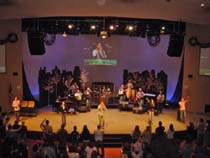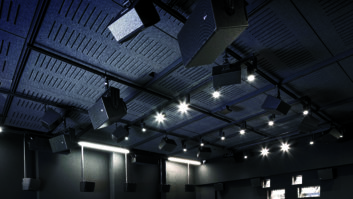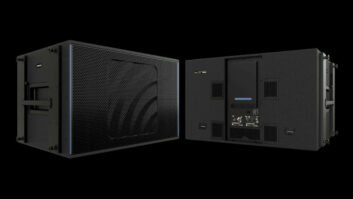
Puyallup Foursquare Church in Puyallup, Wash. resides in a 50,000-square-foot space. With seating for 1,200 and room for growth, the building was suitable but needed an interior upgrade to accommodate Puyallup Foursquare’s upbeat worship style. Church leaders decided on a complete remodel. “Basically, we needed systems that won’t limit either our audio or visuals in any way,” says Pastor of Technical Ministries, Brent Todd, one that can “handle both live performance and live broadcast, as well as recording and videotaping events.”
For the sound system work, the church turned to Steve Palermo, owner of Tank Audio in Seattle, who instantly saw a challenge in the layout of the auditorium itself. Fan-shaped like a baseball field, it has a balcony and a 60-foot-wide stage. In such a potentially reverberant space, the audio would need to capture both individual voices and the full band onstage. Palermo decided to acquire and install Meyer Sound’s M2D compact curvilinear array loudspeaker.
“With all the energy that the band, choir and worship leader put out, they needed a sound system that would provide the same impact [for all of those uses] and I immediately thought of the M2D.” Palermo says. To help create the specification, Palermo enlisted Elton Halley of DECK Productions in Stockton, Calif., who looked to Meyer Sound’s acoustical prediction program, MAPP Online Pro.
Working from hand-drawn sketches, Halley defined the room in MAPP Online Pro and fine-tuned the loudspeaker system design within it. The design called for two arrays of five M2D cabinets, with low frequencies provided by a pair of 700-HP ultra-high-power subwoofers. The array speakers are toed in slightly to minimize any audio interaction with the side walls of the room. “You have to have intelligibility, especially in a church,” Halley says.
The project faced a slight roadblock when it was time to put the subwoofers in place. MAPP Online Pro had suggested placing them beneath the stage, but the building’s structural foundation dictated otherwise. “If we would have chiseled out the concrete, we would have hit dirt,” says Palermo. So instead, in a configuration also developed via MAPP Online Pro, Palermo and Halley built soffits to contain the subwoofers in the walls on both sides of the stage area, about three feet off the ground. The idea, Palermo explains, was “to shoot the energy of that sub into the sanctuary rather than having it go up the walls.
“The projection from MAPP came out in real life exactly as predicted,” Palermo adds.
For more information, visit www.meyersound.com.







